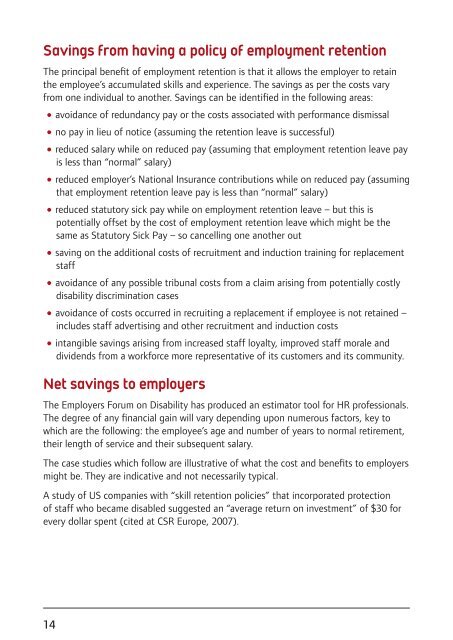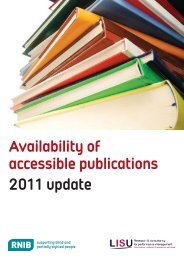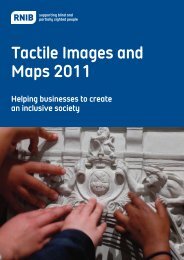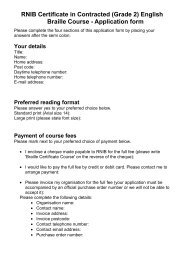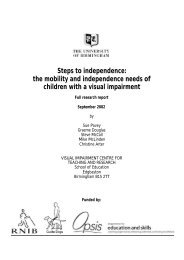Vocational rehabilitation: The business case for retaining ... - RNIB
Vocational rehabilitation: The business case for retaining ... - RNIB
Vocational rehabilitation: The business case for retaining ... - RNIB
Create successful ePaper yourself
Turn your PDF publications into a flip-book with our unique Google optimized e-Paper software.
Savings from having a policy of employment retention<br />
<strong>The</strong> principal benefit of employment retention is that it allows the employer to retain<br />
the employee’s accumulated skills and experience. <strong>The</strong> savings as per the costs vary<br />
from one individual to another. Savings can be identified in the following areas:<br />
avoidance of redundancy pay or the costs associated with per<strong>for</strong>mance dismissal<br />
no pay in lieu of notice (assuming the retention leave is successful)<br />
•<br />
reduced salary while on reduced pay (assuming that employment retention leave pay<br />
is less than “normal” salary)<br />
• reduced employer’s National Insurance contributions while on reduced pay (assuming<br />
that employment retention leave pay is less than “normal” salary)<br />
• reduced statutory sick pay while on employment retention leave – but this is<br />
potentially offset by the cost of employment retention leave which might be the<br />
same as Statutory Sick Pay – so cancelling one another out<br />
• saving on the additional costs of recruitment and induction training <strong>for</strong> replacement<br />
staff<br />
• avoidance of any possible tribunal costs from a claim arising from potentially costly<br />
disability discrimination <strong>case</strong>s<br />
• avoidance of costs occurred in recruiting a replacement if employee is not retained –<br />
includes staff advertising and other recruitment and induction costs<br />
• intangible savings arising from increased staff loyalty, improved staff morale and<br />
dividends from a work<strong>for</strong>ce more representative of its customers and its community.<br />
Net savings to employers<br />
<strong>The</strong> Employers Forum on Disability has produced an estimator tool <strong>for</strong> HR professionals.<br />
<strong>The</strong> degree of any financial gain will vary depending upon numerous factors, key to<br />
which are the following: the employee’s age and number of years to normal retirement,<br />
their length of service and their subsequent salary.<br />
<strong>The</strong> <strong>case</strong> studies which follow are illustrative of what the cost and benefits to employers<br />
might be. <strong>The</strong>y are indicative and not necessarily typical.<br />
A study of US companies with “skill retention policies” that incorporated protection<br />
of staff who became disabled suggested an “average return on investment” of $30 <strong>for</strong><br />
every dollar spent (cited at CSR Europe, 2007).<br />
14


